Where Have U.s. Service Members Been Deployed Since 2000
The proposed global redeployment of U.S. troops coupled with the open question of how long U.South. forces will stay in Iraq highlight the need for objective information on force deployments, objectives, and results. Surprisingly, no comprehensive fourth dimension series data on U.South. troop deployments by year and country seem to exist in a unmarried dataset. This study remedies that demand by introducing a comprehensive troop deployment dataset for 1950–2003.[1] The Troops dataset is available here: www.heritage.org/Research/NationalSecurity/troopsdb.cfm.
Highlights
-
On average, 22 percent of all U.Southward. servicemen were stationed on foreign soil during 1950–2000.In 2003, 27 per centum were deployed, which is roughly the boilerplate of the 1950s. The low point in percent terms was 13.7 percent in 1995, while the high points were 31 percent in 1951 (approximated) and 1968.
-
There were a total of 118.eight million billets during 1950–2000.There have been an boilerplate of ii.33 meg armed services personnel on active duty per year from 1950–2000. That is, during those 51 years, in that location were 118.82 million billets (with "barracks" defined as one serviceman for ane year). Of that full, 27.iii one thousand thousand billets were overseas assignments.
-
In 2003, 387,920 troops were stationed on foreign soil.This figure is out of a total of 1,434,377 personnel. Deployments have ranged from a loftier of 1,082,777 troops in 1968 to a low of 206,002 in 1999.
-
Since 1950, 54 countries take hosted at least ane,000 American troops.Troop deployments are widespread every year. During the past l years, 54 different countries have hosted 1,000 or more than U.South. troops at one signal. During the typical year, 20 countries hosted 1,000 (or more) U.Due south. soldiers. An additional 11.viii countries hosted 100 to 999 American troops. During the 1990s, troops were concentrated in fewer countries. In 2003, fourteen countries hosted one,000 or more American troops, the same number of countries every bit in 2000.
-
Foreign deployments have been concentrated in Europe and Asia.The number of U.Due south. troops in Europe and Asia dwarfs the scant troops stationed in the other three regions: Africa, the Eye E, and the Americas (excluding the United States). During the second one-half of the 20th century, 52 pct of deployed troops were in Europe and 41 percent in Asia. More ane-third of troop deployments during 1950–2000 were to Germany alone, which hosted over 10,000,000 U.S. military machine personnel.
V Decades of Extensive Foreign Deployments
Those who closely follow U.Due south. defense posture know that President George W. Bush'due south August 2004 announcement of a proposed global redeployment of U.South. troops was predated by many years of preparation and planning. "The world has changed a great deal and our posture must change with it," President Bush-league said. The programme volition withdraw 70,000 troops from Europe and Asia, continuing the departure from the Common cold War stance of 1950–1990.
Although the announced moves have been characterized past some as dramatic -- even risky -- they are really part of an ongoing process of threat assessment and long-range planning at the Pentagon. For instance, the major post-Common cold War drawdown of U.Southward. troops in Europe occurred in the early 1990s, when hundreds of thousands of American soldiers were brought home from Germany.
The current proposed realignment is thus neither the outset nor the last step in modernizing America's global war machine posture, although it does raise the question anew: What is the role of the U.Southward. military in the world? To begin, nosotros should enquire what the global role of the U.South. armed services has been in the past, and whether information technology has been effective.
Nevertheless, no comprehensive source exists that could show where U.Due south. troops have been deployed for the by 50 years. The Center for Data Assay has remedied that past providing a comprehensive troop deployment dataset for 1950–2003. Although the Pentagon publishes annual troop deployment figures, it was necessary to compile the data into an integrated, comprehensive database to compare troop locations across dissimilar years. The integrated data series described below offers a unique perspective on the constant modify involved in troop deployments away.
On average, 2.3 million U.Southward. troops were on duty per year from 1950–2000. Of this average, 535,000 troops (23 percent of all armed forces personnel) were deployed on strange soil. Nautical chart 1 shows the fourth dimension series of the percent of troops deployed abroad. The pattern of deployment varies over time, equally deployment locations and levels respond to changing threats also as strange wars.
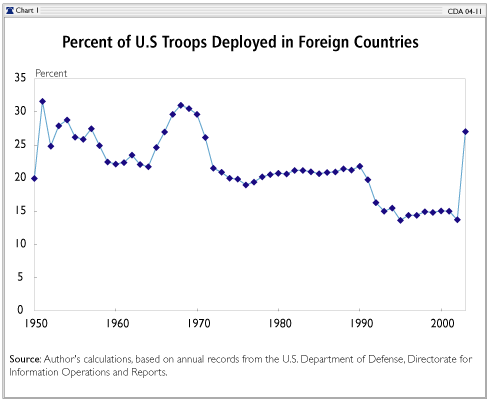
Using the integrated data, we tin mensurate how many countries host a given number of troops every yr and how that pattern of deployment breadth evolves. Chart 2 shows the number of countries hosting 100 or more troops per year over fourth dimension and the number of countries hosting ane,000 or more than troops per yr.
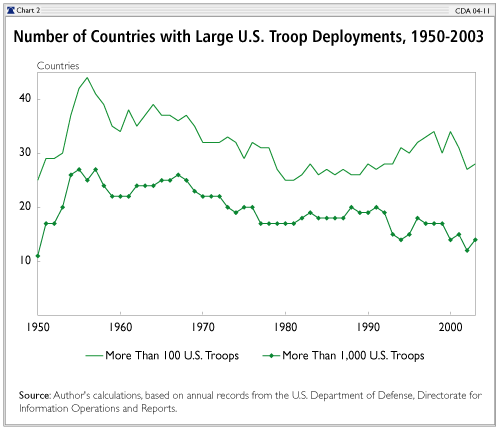
The dataset does not distinguish the type of personnel by military branch or mission. Researchers may discover information technology useful to make such a distinction. For the virtually role, U.S. troops were stationed away every bit part of the Cold War arrangement of deterrence through alliances with nations such as Japan, S Korea, and NATO member nations. While such defensive missions were the norm, troops sent to Korea in the early on 1950s and to Vietnam during the 1960s were actively at war, as are those currently in Iraq. A qualitative description of troop deployments would accept to distinguish these situations from the norm. Combat troops can exist further categorized in two ways (at a minimum) -- attacking or defending. Non-combat missions could exist further described in terms of deterrence, pacification, engineering, diplomacy, and so on. The nigh of import nomenclature is whether U.Due south. troops are welcome or unwelcome by the host nation. In the overwhelming percentage of cases, they have been welcome as office of a common agreement.
Asymmetric Posture in Five World Regions
The commitment of American soldiers has been consistent in Europe, varied in Asia, and shallow in the other parts of the globe. Chart three gives a decade-by-decade bookkeeping of troop deployment by major region. The number of U.South. troops in Europe and Asia dwarfs the scant troops stationed in Africa, the Middle E, and the Americas (excluding the United States). During the second half of the 20th century, 52 percent of deployed troops were in Europe and 41 percent in Asia. Most of those deployments can be traced to a scattering of countries: Germany, Nippon, and Vietnam. Many nations still have thousands of U.Southward. troops on their soil as part of long-standing alliances, but many of the countries that have been home to American forces would exist a surprise to contemporary perceptions, because they include France, Spain, Portugal, and fifty-fifty Great socialist people's libyan arab jamahiriya.
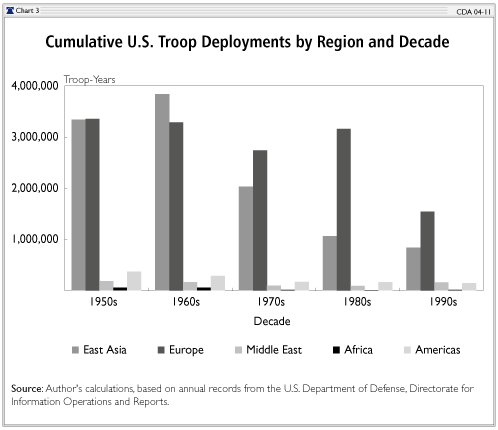
Federal republic of germany, past a wide margin, has the highest troop-year total for every individual decade and for the entire 1950–2003 period. Chart 4 is a graphical list of the 20 countries in order of the total amount of troops. Nippon, South Korea, Vietnam, and the United Kingdom round out the height 5 countries that have hosted the most U.Due south. armed services personnel and are included in Chart 5 as time series over the entire period. Evident in Chart five is the rapid rise and decline of the number of troops sent to Vietnam -- from less than 1,000 personnel in 1961 to 537,000 in 1968, so quickly down to nothing seven years after. Chart six shows time series for the next five countries with the highest total deployments: France, the Philippines, Italian republic, Panama, Thailand, and Espana.
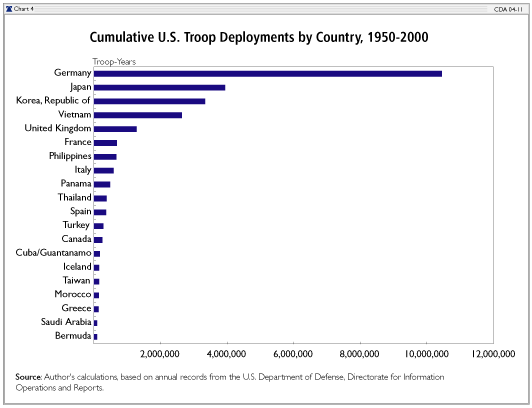
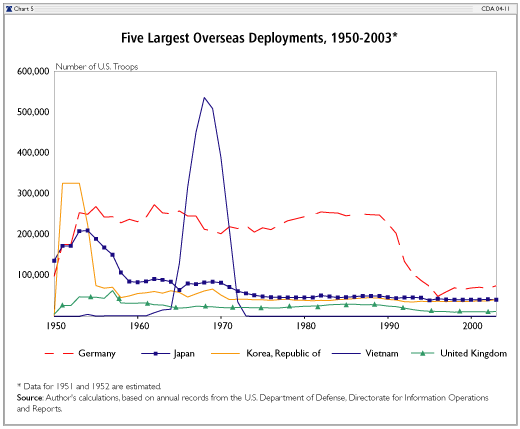
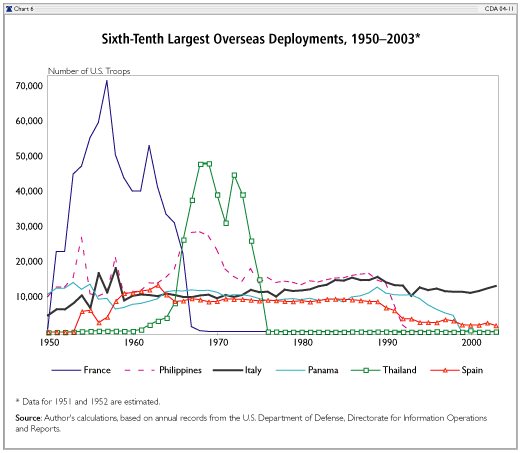
The post-obit subsections describe in some item the changing strength composition in the five regions over the past 54 years.
Region 1: East Asia. The historical roots of the U.S. are almost entirely European, but the 20th century saw a deepening appointment into the diplomacy of Asia. Most of that appointment focused on Japan and the postwar occupation, but the 1950s were besides dominated past the Korean War. As a consequence of these 2 developments, U.S. bases accept become a seemingly permanent feature of Due east Asian security. The data ironically indicate a sharp pullback of U.S. forces from Asia in the 1970s and 1980s, but this is primarily driven by the end of the Vietnam conflict and complete withdrawal from there. Troop commitments to Japan and Southward Korea formed a bedrock of U.S. engagement in Northeast Asia.
What might accept been viewed as an occupation of Japan subsequently 1945 was instead transformed by the threat of mainland china and the Soviet Union into a mutually benign security arrangement and strong brotherhood. Other postwar relationships also evolved into long-continuing alliances involving heavy U.S. troop commitments, notably in the Philippines and Taiwan.
The U.S. role in Korea was motivated by the sudden assail from Democratic people's republic of korea, which ultimately served to validate the strategy of containment, that is, the need to aggressively contain communist ambitions. Just 510 servicemen were based in South Korea in 1950, prior to the assault. U.S. Department of Defense (DOD) records bear witness that 326,863 troops were deployed in South korea in 1953, a number that stabilized between 50,000 and lx,000 in the 1960s and 1970s. A slow drawdown continued as troops averaged twoscore,000 in the 1980s and 35,000 in the 1990s.
America positioned thousands of troops in Hong Kong and Taiwan, abruptly starting in 1954. At their pinnacle, there were 4,539 American soldiers in Hong Kong in 1957, which were quickly drawn down to levels of 290 and and then 26 over the next two years. The state of affairs was similar in Taiwan, with a sudden buildup from 811 to iv,174 troops in 1954, peaking in 1958 at xix,000 and then stabilizing between iv,000 and x,000 until 1977. All American forces were pulled out in 1979, a withdrawal that clearly began in 1973 later on President Nixon's diplomatic opening with the People's Democracy of Prc.
The war in Vietnam brought hundreds of thousands of American military personnel from all branches to many countries in Southeast Asia. Hundreds of soldiers had been in Vietnam since the cease of World State of war II, but 1956 marked the beginning of new deployments into Cambodia and Laos. Troop levels in Vietnam proper accelerated sharply in 1962, peaked in 1968 at over 500,000 servicemen, and so declined sharply every twelvemonth after, ending with consummate pullout in 1975. Thailand also saw large deployments of tens of thousands of Americans during 1962–1975, when information technology hosted large U.S. airbases that were heavily used to support combat operations in Vietnam.
The Philippines hosted a steady level of 15,000 U.Due south. billets per year throughout iv decades, with large Air Force and Navy bases. Then a series of protests, capped past a devastating volcano eruption that devastated the bases, severed the deployment relationship after 1992.
Region two: Europe.It is impossible to consider the defense posture of American forces in Europe without beingness impressed by the dominant position of Germany, which was split in one-half past post-1945 occupations of Soviets in the East and the other Allies in the Due west. As relations hardened between the Cold State of war adversaries, Germany became the primary potential battleground for World War III and U.Due south. troop levels tripled from 1950 to 1953. Every year for nearly iv decades, one-quarter of a one thousand thousand troops were billeted in West Germany, but by 1993 the number had dropped to 105,254. In 2000, just 69,203 American military machine personnel remained.
French republic had some 50,000 U.S. troops based on its soil for decades, but that number was reduced to less than 100 during the mid-1960s.
Beyond the residuum of Europe, at that place accept been many unlike hosting relationships over the half-century. Britain saw the withdrawal of tens of thousands of U.S. soldiers after 1990. In Italy, the number of U.S. servicemen has remained remarkably stable to this day, averaging about 12,000. In contrast, a similar deployment level in Espana of ix,000 troops was trimmed sharply to ii,000 after 1989. The stop of the Cold War also led to U.Southward. personnel reductions of l percentage or more in countries such equally Portugal, Iceland, Greece, and holland. The major exception was the deployment of xv,003 soldiers to Bosnia and Herzegovina in 1996 and the steady presence of 3,000 troops there always since.
Region 3: Heart East. Turkey is categorized here as a Middle Eastern country, but has equally as much European heritage. Turkey's close friendship with the U.S. during the Cold State of war included the basing of five,000 to 10,000 American troops from 1957 to 1992, when a slow drawdown began. Roughly 5,000 American troops were in Libya per year during the 1950s and 1960s. The just other major deployments to the Middle East were in Kuwait and Saudi Arabia first in 1990. In contempo years, the U.S. has deployed troops to new bases in Qatar and Bahrain.
Still, it would exist a mistake to think American forces have not been widely deployed in the Middle Eastward. Thousands have been based in Iran, Islamic republic of pakistan, Morocco, and Saudi Arabia over the decades. Hundreds more have been based consistently in Egypt, Lebanese republic, Israel, and India.
Region 4: Africa. Africa is the clearest case of non-involvement by U.S. military forces during the past five decades. A scattering of African nations saw very pocket-size deployments beginning in the 1960s, but nothing on the scale of strategic basing seen in other continents. The exceptions to this dominion are Libya (described above) and Federal democratic republic of ethiopia, which hosted over ane,000 American soldiers every twelvemonth from 1957 to 1973. By the 1980s, most African nations had minor troop deployments of five to 50 American soldiers. This may signal more engagement and is certainly attributable to more meliorate recordkeeping by the Pentagon, given that small deployments in other regions in the 1950s and 1960s were recorded.
Region 5: Americas.American forces have been broadly, lightly based throughout Latin America since 1950. The strongest relationships in the hemisphere take been with Canada, Panama, and Bermuda, each with basing commitments of 3,000 to 15,000. The number of U.Southward. troops stationed in Canada declined sharply from 1965 to 1975 and is now only about 150. Most other nations in the region hosted U.S. forces year after year -- normally less than 100 -- and none had annual billets over 1,000.
Assay
The President's proposed redeployment of 70,000 troops from foreign countries to domestic bases has been greeted as a major movement, but it needs to exist kept in perspective. An boilerplate of 311,870 troops were stationed in Europe per year during 1986–1990. That force was slashed by two-thirds after the Berlin Wall fell, to an average of 109,452 troops per year during 1996–2000.
U.Southward. troops were disengaged (i.eastward., reduced) from Africa in the early 1970s. In Latin America, the disengagement was sharper, declining from an boilerplate of 37,000 soldiers annually in the 1950s to 28,000 in the 1960s to a steady xiv,000–16,000 thereafter. Troop deployments to the Middle East were cut in half during the 1970s and 1980s, but redoubled in the 1990s.
A final analytical consideration is the impact of U.Southward. troops on foreign countries. In postwar Germany and Nihon, the goal of the U.S. presence was Common cold State of war peace through deterrent strength. One can argue that the mission was largely successful, not only for the U.Due south., only also for the economic development of the 2 respective regions.
On the other hand, ane could also argue that the dominance of American forces can serve as a crutch of inaction by others. For example, the tragedy of genocide in Bosnia was unchecked without U.S. leadership. Withal is the primacy of U.Due south. appointment in addressing obvious atrocities a healthy development?
No other military in earth history has been so widely deployed as that of the United states of america. Troop deployments are overwhelmingly supportive of host countries, and warm relations between soldiers and local populations are the norm. Nonetheless, the get-go priority in deployment strategy is non a item foreign regime'due south desire to keep a sure number of American troops in its country, only the American demand to marshal its forces against contemporary and futurity threats. Better information about the deployment levels of American forces will hopefully contribute to an understanding of the consequences of past strategies and the evolution of time to come strategies.
Tim Kane, Ph.D., is Research Swain in Macroeconomics in the Middle for Data Assay at The Heritage Foundation.
Appendix
Data and Methodology
The original annual information come up from the Statistical Information Analysis Division (SIAD) of the Advisers for Information Operations and Reports (DIOR) in the U.S. Department of Defense. The SIAD makes the data publicly available via its Web site,[2] although it is bachelor only on an annual ground, not as a time series. Data for years 1950 through 1977 are in Microsoft Excel format, and data for following years are in Adobe Acrobat format.
Our starting time research objective was to create a comprehensive disaggregated table showing how many U.S. troops were deployed to each unique country during every year studied. The disaggregation allows one to correctly account for countries that underwent changes in proper name or geographic purlieus. For example, modern Federal republic of germany is a fusion of old Due east Deutschland with Westward Germany, while at the terminate of 1991 the Soviet Union disintegrated into 15 independent republics. The disaggregated tabular array includes 250 countries in rows, along with 54 columns representing troop counts for the years 1950–2003.
The second objective was the creation of an integrated table which aggregates varied country names and associated data into a single time series. For example, the Japan data include data on Japan, as well as Okinawa and the Bonin Islands, which were counted separately during the 1950s and 1960s. Scotland (1954–1955), Trieste (1950–1954), and the Azores (1950–1969) were uniquely identified in DOD records and were integrated into the Uk, Italian republic, and Portugal records, respectively, for the "integrated" spreadsheet. Others like Myanmar take integrated information for Burma, its longstanding country name in earlier records. Then there are cases of continuation on the integrated sheet, such equally Russian federation, which denotes gimmicky Russia and data from the onetime Soviet Marriage. The resulting integrated canvas gives a clearer overview of U.S. troop deployments over the past 55 years.
The integrated data have some inherent limitations:
- Annual troop counts are a snapshot of the level of military personnel stationed aground during one month of the year. For the 1950s data, the reference date was generally June 30, while afterward years used September 30, which is the finish of the fiscal year. We assumed that each count represents a full troop-yr or "billet." For case, the count of 53,074 in France in 1962 represents the total billets, not the full number of U.Southward. personnel who served in France that yr. Exactly 53,000 men may take served one-yr tours, or twice as many individual soldiers could have served one-half-twelvemonth tours of duty, but the number of billets is the same in either example.
- Original information for some years do not distinguish between "ashore" and "afloat," while other years exercise. We fabricated every effort to reconcile the values and to count the personnel actually inside the country.
- Original data for the years 1951 and 1952 are not available, and we used approximated values. DOD officials speculate that the data for troop locations during the Korean State of war were either never recorded or peradventure destroyed at some bespeak for security reasons.
- Gimmicky data understandably do not offer great particular on placement of personnel in the Middle East and only count the total number involved in Functioning Iraqi Freedom, which nosotros assign wholly to Iraq.
Where Have U.s. Service Members Been Deployed Since 2000,
Source: https://www.heritage.org/defense/report/global-us-troop-deployment-1950-2003
Posted by: moralesdarke1999.blogspot.com


0 Response to "Where Have U.s. Service Members Been Deployed Since 2000"
Post a Comment